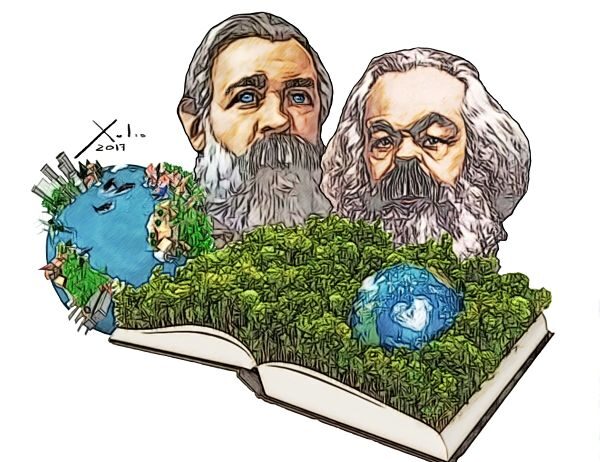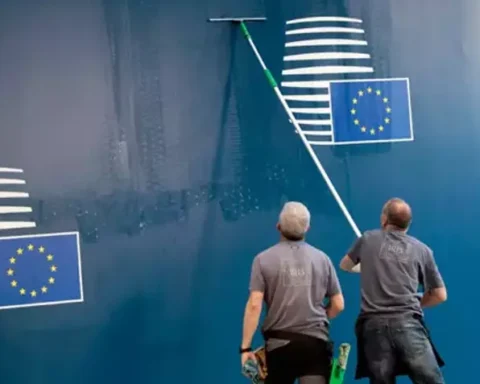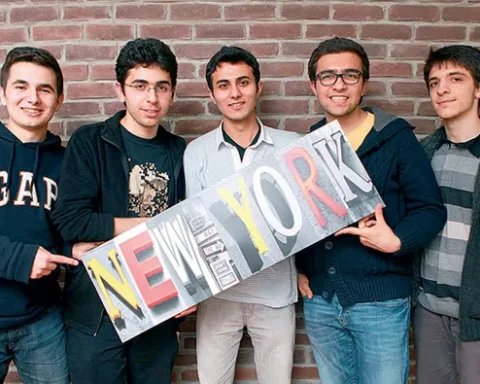Uncovering Marx the ecologist
This is the first in a series on Possible Worlds, envisioning alternatives to the current system in the spirit of “Another world is possible.” Confronting our current political situation, we need to go beyond the defensive to explore how we came to this place and how we can make the systemic changes needed to move beyond it. In the series I will review books and other sources, some relatively new, some classics, to help inform this exploration.
It’s not what you think
Degrowth communism. It is hard to think of two more triggering words. Words which raise red flags. One quite literally.
Then put together, it is difficult to conceive of two more seemingly contradictory terms. Degrowth, which to many raises images of voluntary poverty in a somewhat bucolic, post-industrial, neo-anarchistic setting. Contrasted with communism, which stirs up pictures of Soviet smokestacks, forced industrialization to drive increased production.
That gets it all wrong, says Japanese author Kohei Saito, whose 2020 bestseller in Japan, Capital in the Anthopocene, was recently released in an English translation under the more attractive title, Slow Down: The Degrowth Manifesto. Degrowth, while implying a lower level of material consumption, means abundance in values not captured in Gross Domestic Product statistics, particularly the most valuable, our time, says Saito.
Regarding communism, Saito invites us to discover a different Marx, one who emerged in the latter years of his life, who looked beyond the industrial world of Western Europe that informed his early work to non-Western, indigenous and ancient communal models. One might even recast his revised understanding as communalism or common-ism. For, to Saito, the true meaning of communism is to reclaim the commons walled off by capitalism. That points a pathway to a sustainable future even for people who might resist that challenging term, degrowth communism.
In the introduction to the English edition, Saito notes how he had little hope for his book when it was published in Japan. “Even I thought my ideas were too radical to find much of an audience. Who would read a book on ‘degrowth communism’ written by a basically unknown scholar of political thought in the Marxist tradition? But I was utterly wrong about that. It sold half a million copies.”
If the English translation is any clue, part of the reason for that is an accessible writing style that presents ideas in an engaging form. Saito has much to say in this compact work that a short review can barely cover. But I will try to hit the key points, and supply my own critique.
Saito centers his work on the climate crisis, which he views as an organizing principle to bring together many disparate causes into a unified movement for a truly sustainable world. The crisis, in his view, is the ultimate expression of the key dynamic of capitalism identified by Marx, the externalization of costs onto the commons to maximize private profits. The atmospheric commons has been made a dumping ground for CO2 and other pollutants, securing great concentrations of wealth and prosperity for the Global North at the expense of climate disruption, with its most severe consequences hitting the Global South.
“Our current climate crisis demonstrates that we’ve already reached the outermost limits of externalization society,” Saito writes.
Our Imperial Way of Life catching up on us
Saito quotes German sociologists Ulrich Brand and Markus Wissen who describe the lifestyle of the Global North as the Imperial Way of Living. It is characterized by “large scale production and consumption. This is what makes our rich lifestyles possible. Beneath this surface, there exists a structure by which the cost of our consumption is extracted from the lands and labor of the people of the Global South. Without the exploitation of others who pay the costs, the Imperial Way of Living would be unsustainable . . . “
“ . . . We cannot stand to look the truth in the face . . . our response to the current crisis ends up being put off to a future that never comes. In this way, each and every one of us is complicit in perpetuating injustice. But the just desserts for this procrastination have already begun filtering back into the core.”
The environmental crisis has reached close to the point of no return because the externalization of costs inherent to capitalism. “Coddled by the invisibility of our lifestyle’s costs, those of us living in the Global North have been able to turn our backs on reality . . . “ For the top 10-20% of us who live on the top, the world seems stable. But that will fade as the crisis grows more intense. Only the top 1% will be able to maintain current lifestyles, leading to one of four futures:
- Climate fascism, in which large numbers become climate refugees while the elites employ disaster capitalism to become richer and use government powers to crack down on refugees and vulnerable populations. The U.S. and Western Europe seem well down this path.
- Barbarism, in which refugees proliferate, food production collapses and popular uprisings overturn authoritarian states, while militias run wild in a “war of all against all” in which everyone will pursue their own individual survival.
- Climate Maoism, in which a centralized dictatorship overturns the free market and liberal democracy to allocate limited resources.
- Degrowth communism, in which community institutions have reclaimed the commons and are building horizontal networks among themselves, some in the context of the state, which will still be needed to address the climate crisis, but many beyond them.
Making the case for degrowth
Saito spends much of the book describing how the latter might work, and how it is grounded in the later studies of Marx. I will review those studies below. First, let us examine Saito’s arguments for degrowth and against concepts of green growth.
As with many degrowth advocates, Saito is inclined to definitive statements critical of green technologies and initiatives that downplay the need for change in our way of life. “ . . . an optimistic belief in green technologies and green growth may be nothing more than a ploy to buy time for capitalism.”
Saito expresses deep skepticism about the possibility of decoupling economic growth from increased resource consumption and pollution. “The dilemma is this: as the economy grows, the range of human economic activity grows too, which means that the volume of resource and energy consumption also grows, making it difficult to reduce carbon dioxide emissions. This is a historic tendency.”
“Economic growth and fossil fuel consumption are intimately and inextricably linked, and thus fossil fuels cannot be replaced with green energy. It’s physically impossible to sustain the same level of economic growth as before and reduce carbon dioxide emissions at the same time.”
The author also cites the fact that so far, even as renewable energy has rapidly grown, so has fossil fuel use. Solar and wind have carried part of economic growth, but fossil energy has still been required.
Saito cites the Jevons Paradox, named after the 19th century British economist who found that greater efficiency in coal use did not reduce the amount of coal used, but because coal prices were reduced increased it. This is also known as the rebound effect. A simple example is if you’re using a highly efficient LED bulb you might be less diligent about turning off lights in rooms not being used.
A critic of electric vehicles, Saito cites the increased need for cobalt and lithium in batteries as an example of the plunder of the Global South caused by a shift to green technologies.
For all these reasons, Saito dismisses the assumption growth as usual can continue, even with initiatives such as the Green New Deal. But he has a more balanced approach than some ecological fundamentalists who altogether deny the role of green technologies and initiatives.
“Make no mistake – Green New Deal-style government platforms enabling large-scale investment into remaking nations at a fundamental level are absolutely indispensable in the struggle to combat climate change. It is undeniable we must make the transition to solar energy, electric vehicles, and the like. Public transportation systems must be expanded and made free for all, bicycle lanes must be built, and public housing fitted with solar panels must be created – these sorts of public works projects, driven by public spending are all vital.
“But these things are simply not enough. It might sound counterintuitive, but the goal of any Green New Deal should not be economic growth but rather the scaling down and slowing down of the economy.”
But does the case stand up?
Saito’s arguments have cogency as far as they go. But they suffer from being too definitive in the face of real world developments. In fact, significant decoupling of economic growth from CO2 emissions is being documented. This piece from Our World In Data illustrates this, and ascribes it to the growth in low-carbon energy. This includes the U.S. where average incomes have increased 10% while emissions per capita have decreased by 32%. These countries are mostly higher income. Importantly, the data shows consumption-based emissions reflecting imports. So it is not a matter of displacing pollution to high-emissions countries.
It is also documented that in many parts of the world, including the U.S. and Europe, renewables are actually replacing fossil energy. This includes the states of California and Texas, the U.S. leaders in deploying renewables. Most of recent growth in climate pollution has come from China, but even there it appears renewables will cause a peak in coal emissions and then a decline in the next few years. This is documented in this piece by Nafeez Ahmed at his of Age of Transformation site. Ahmed, definitely an optimist, posits that a super-abundance of renewable energy will enable recycling of solar panel, wind turbine and battery materials that eliminates fresh resource extraction. Meanwhile, the world battery leader, China-based CATL, just announced mass production of next generation sodium ion batteries with nearly the energy density of lithium ion batteries, eliminating lithium use entirely with far more abundant sodium.
Saito’s stronger arguments against decoupling through green technologies are not in the realm of whether or not these are possible. Rather, with the dynamics of capitalism, the issue is whether the energy transition will be sufficient to meet the climate crisis. Saito himself seems to acknowledge decoupling to some extent is possible, but asks, “Can a Green New Deal conducted under capitalism solve the problem in time? As long as reform takes place in a capitalist framework it will always tend to privilege growth. As we’ve seen, this will inevitably lead to an inability to realize sufficient absolute decoupling, amounting to nothing more than an ineffective half measure.”
While there is clearly progress, much spurred by public policies rather than the workings of capitalism, the evidence so far is that the crisis is outracing the gains. CO2 rose at a record rate in 2024. Carbon pricing schemes have been enacted to internalize costs that have been externalized, but industry resistance prevents a level of pricing that fully accomplishes that goal. Meanwhile the more fundamental questions of how the Imperial Way of Living causes plunder of the Global South are not being answered. Mining for green technologies, even though far less impactful than fossil fuel extraction, disproportionately impacts the Global South.
So Saito’s fundamental argument, that we must slow down the economy and reduce material consumption to turn around the climate crisis, remains potent. If anything, the breaching of multiple ecological limits beyond climate makes it stronger. For what Marxian thinking offers in this regard, we must turn to Saito’s deep dive into the ecological Marx he discovered participating in a global project to uncover Marx’s lesser known writings.
Uncovering the ecological Marx
Saito writes, “Degrowth through Marx? Are you crazy? I began writing this book well aware that I’d face this sort of disbelieving response from all quarters.”
That is because the Marx most of us know is the Marx who boldly proclaimed the industrial revolution taking place in Western Europe when he wrote in the mid-19th century was needed to realize his vision of communism. It is the Marx of productivism, Saito writes. The capitalist bourgeois in revolutionizing production would accumulate so much wealth unto themselves that they would impoverish the working class, which would as a result seize the means of production and place them under direct worker management.
The fact this didn’t happen, and that the actual Marxian revolutions that did take place in Russia and China were in agrarian societies and more caused by the upheavals of war, are taken as a refutation of Marx. Labor unions and progressive reforms resulted in some redistribution of income in the west, while the Soviet and Chinese regimes became massive state capitalisms under the control of bureaucrats rather than workers. Saito is critical of these regimes for just these reasons.
Saito instead looks to a different Marx, one whose ecological leanings emerged more in the latter days of his life. He draws heavily from a global project to surface and publish the complete writings of Marx and his partner, Friedrich Engels, including Marx’s extensive, previously unpublished notes. Marx at the time of his death had not completed the second and third volume of Capital, leaving that to Engels. Saito speculates that Marx was having difficulty integrating his new insights, which Engels did not fully capture.
Writing the first volume, Marx had already been influenced by Justus von Liebig, a German chemist who concluded that commercial agriculture robbed the soil. Modern sewage treatment broke the older cycle of returning human wastes to fertilize it. Increased pressure to produce for profit intensified depletion. Commercial agriculture displaced these costs through use of fertilizers, such as the bird guano collected from islands in Marx’s day. Today fertilizers are mined and made from fossil gas, neither sustainable.
Marx’s later notes reveal his “hitherto buried ecological critiques of capitalism,” Saito writes. “ . . . his notes reveal that his research led him beyond Liebig’s critique of modern agriculture as robbery. The range of Marx’s late life study of the natural sciences is astounding . . . He addressed ecological issues as diverse as the overharvesting of forestland, the waste of fossil fuels, and the extinction of seeds as arising from the contradictions of capitalism.”
Marx saw how the metabolic relationship between humans and nature, the cycle of exchange at the heart of ecological thinking, was broken by capitalist extraction to accumulate wealth. Marx likewise saw the extraction of surplus value from workers by capitalists as another robbery, causing an “irreparable rift in the interdependent process of social metabolism.” Capitalists use technological innovation to continue to displace the costs, “widening the scope of this ‘irreparable rift’ to global proportions,” Saito writes.
The climate crisis is the maximal expression of this. It is true that a general increase in prosperity has expanded the pie, giving the laboring classes a big enough slice to avoid the uprising Marx envisioned. But this has been propelled by massive increases in fossil fuel use, displacing the costs to the atmosphere, eventuating in climate disruption. The planetary metabolism has been upset.
Thus, asserts Saito, the latter Marx “broke away from his earlier superficial celebration of productivism . . . Marx was, at this point, convinced that sustainable growth was impossible under capitalism, that capitalism would lead to nothing but the further intensification of nature’s plunder.” In this Marx was ditching his earlier ecosocialism that still saw growth as possible. He was moving away from seeing the Western European industrial model as inevitable, or any sense history had to progress through certain stages. Marx was seeking a model of sustainable development that would restore the metabolic balance of humans and nature. For that he turned to the preindustrial past.
Looking for the future in the past
In 1868, immediately after the publication of the first volume of Capital, Marx turned not only to study of the natural sciences, “but also into the land use and agricultural practices in non-Western and precapitalist societies. He read extensively on ancient Rome. Indigenous peoples in America, India, Algeria, and South America. He also took great interest in agricultural communes in Russia . . .” These communities were defined by communal management in egalitarian settings, aimed not at growth but at maintaining a sustainable, steady-state economy. For instance, ancient German tribes that practiced communal agriculture barred selling products outside the community, while rotating plots so no one would be advantaged by better soils on some. These communal models exhibited a fundamental social equality that, in Saito’s view, is a necessary prerequisite for sustainability.
Saito identifies a response to an inquiry by Russian revolutionary Vera Zasulich in 1881, close to the end of Marx’s life, as most clearly showing his break with his earlier thinking. Russian revolutionaries called Narodniks argued that Russia did not have to go through capitalist industrialism to attain socialism, but could by expanding agricultural communalism. Could the communes indeed avoid a capitalist stage? Marx replied, “ . . . the present Russian common ownership of land may serve as the starting point for a communist development.”
Based on his studies of ecology and communal societies, Marx was finding “a new vision of revolution,” Saito asserts. He no longer saw history as inevitable progress through defined stages. Increased productivity would in fact lead to environmental destruction and social collapse. Europe was no longer the model. He writes Zasulich, “The best proof that this development of the ‘rural commune’ is in keeping with the historical trend of our age is that fatal crisis which capitalist production has undergone in the European and American countries where it has reached its highest peak, a crisis that will end on when the social system is eliminated through the return of modem societies to the ‘archaic’ type of communal property.”
“In short,” writes Saito, “the communism envisioned by Marx late in his life was an egalitarian, sustainable form of degrowth economics . . . That means that communism like the Soviet Union’s founded as it was on productivism and the promotion of economic growth, will never work.”
Marx was looking to a communal and egalitarian past to shape a sustainable future. Saito is clear this is not a return to a bucolic past of primitive technologies, and indeed writes of the need for technological development that is accessible to communal management, the community solar installation versus the nuclear reactor. He calls this open versus locked technologies.
Writes Saito “ . . . this form of thought is not a nostalgic call to ‘return to the village!’ Or ‘form a commune! – Marx repeatedly said that the Russian mir (the agricultural commune), for example, must incorporate the positive aspects of the technological revolution brought about by capitalism. The revolution he sought in Western Europe would preserve the achievements of modern society even as it called for a form of communism of ‘the most archaic type’ – that is, one that uses a steady-state society as its model.”
But how would this turn to the communal be achieved? How could it create a society of genuine abundance? How can we reclaim the commons? Is there an evolutionary path to achieve such revolutionary change? To these questions we will turn in the second part of this series.
Source: https://theraven.substack.com/p/can-degrowth-communism-save-the-world






